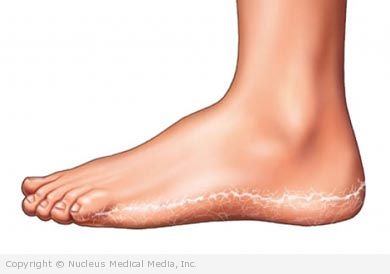Athlete’s foot
(Tinea Pedis)
Athlete’s foot – Definition
Athlete’s foot is a fungal infection that typically occurs on the feet. The infection is common among people who exercise or play sports. Anyone can have athlete’s foot.
Athlete’s foot – Causes
Fungus thrives in warm, dark, moist places. Examples include the inside of a shoe, locker rooms, showers, and swimming pools. Your bare feet come in contact with the fungus when you walk through a contaminated area. The fungus will grow if your feet or the area between your toes stays slightly wet.
Athlete’s foot – Risk Factors
Risk factors that increase your chances of getting athlete’s foot include:
- A history of athlete’s foot infection
- Walking barefoot in locker rooms or public places
- Not keeping your feet clean and dry
- Wearing air-tight or poorly ventilated shoes or boots
- Sweaty feet
- Hot, humid weather
- Disorders of the immune system
Athlete’s foot – Symptoms
Athlete’s foot symptoms usually start between the toes. It may spread to the soles or arches of the feet or to the toenails if the infection continues.
Symptoms often occur in together and may include:
- Dry skin
- Itching, which gets worse as the infection spreads
- Scaling
- Cracking
- Redness
- A white, wet surface
- Blisters, which may open and become painful
Athlete’s foot – Diagnosis
The doctor will ask about your symptoms and medical history. A physical exam will be done. The doctor may scrape a small sample from the infected skin and look at it under the microscope. Infections caused by bacteria may cause symptoms similar to bacteria caused by a fungus. Other conditions may also look like athlete’s foot. Getting an certain diagnosis is important for successful treatment.
Athlete’s foot – Treatment
Treatment aims to rid the body of the infection. Therapy may include good foot hygiene or medication. Many over-the-counter antifungal medications are available. Get medical care if the infection lasts for two weeks or more.
Foot Hygiene
- Gently wash your feet often (at least daily) with soap and water. Completely dry all areas, including between the toes.
- Put a dusting of antifungal foot powder on your feet or in your shoes to absorb moisture.
- Change your shoes and socks frequently.
- Do not swim or use public locker rooms when you have an infection. This will help prevent spreading the infection to other people.
Medication
Over-the-counter topical antifungals may be helpful. You should consult with your doctor if you don’t see any improvement within two weeks of trying them. Prescription topical or oral medications may be more effective. The doctor may prescribe an antifungal medication to be taken by mouth or applied to the feet. Be sure to tell your doctor about any other medical problems you may have had, such as liver or kidney disease, or diabetes.
It is important to continue taking any prescribed medication for the entire time instructed by the doctor. Do not stop any medication without the doctor’s approval. Treatment generally lasts 4-8 weeks. Shortening the treatment plan often results in another infection. Wash your hands after applying topical medications.
Topical medications include:
- Miconazole
- Haloprogin
- Clotrimazole
- Ciclopirox
- Terbinafine
- Butenafine
- Tolnaftate
- Econazole
- Ketoconazole
- Naftifine
- Oxiconazole
- Sulconazole
Griseofulvin is a prescription oral medication. Other oral drugs may also be prescribed.
Athlete’s foot – Prevention
Preventing athlete’s foot can be difficult. Keeping your feet clean and dry will help. Suggestions include:
- Gently wash your feet every day using soap and water.
- Dry carefully between the toes.
- Wear shoes that are comfortable and allow your feet to breathe.
- Wear sandals in the summer.
- Change shoes often.
- Wear cotton socks that pull moisture away from your skin.
- Change socks when they become damp.
- Apply an antifungal foot powder to your feet or shoes.
- Take off your shoes and socks and walk barefoot at home when possible.
- Do not walk barefoot in damp places.
- Wear shower shoes or sandals in public locker rooms.
- Do not borrow other people’s shoes.

